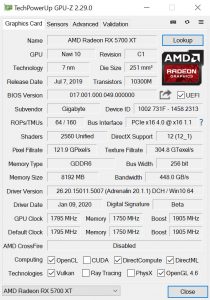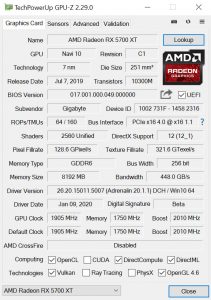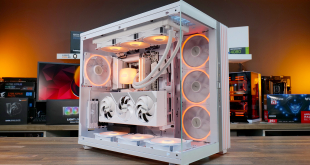Today we are back with a look at not one, but two RX 5700 XT graphics cards. In this review, we are directly comparing the Gigabyte RX 5700 XT Gaming OC to the Aorus RX 5700 XT. For those that don't know, Aorus is Gigabyte's premium sub-brand, and today we see what differences there are between the two cards, and whether or not it is worth paying the extra money for an Aorus model.
The prices of these two graphics cards immediately reflects the different product positioning for each model. The Gigabyte RX 5700 XT Gaming OC is currently £374.99 while the flagship Aorus RX 5700 XT retails for £409.99. That £35 increase over the Gaming OC is almost a 10% price jump for the Aorus model.
So what do you get for that extra money? Well, we won't spoil everything for you here, but the Aorus comes with a higher boost clock, larger cooler and dual-BIOS support. Over the next two pages we take a close look at the difference in design between these two models, before extensively testing the two GPUs in over 10 games to see if there's any meaningful difference in performance.
| RX 5600 XT | RX 5700 | RX 5700 XT | RX Vega 56 | RX Vega 64 | ||
| Architecture | Navi | Navi | Navi | Vega 10 | Vega 10 | |
| Manufacturing Process | 7nm | 7nm | 7nm | 14nm | 14nm | |
| Transistor Count | 10.3 billion | 10.3 billion | 10.3 billion | 12.5 billion | 12.5 billion | |
| Die Size | 251mm² | 251mm² | 251mm² | 486mm² | 495mm² | |
| Compute Units | 36 | 36 | 40 | 56 | 64 | |
| Stream Processors | 2304 | 2304 | 2560 | 3584 | 4096 | |
| Base GPU Clock | n/a | Up to 1465MHz | Up to 1605MHz | 1156 MHz | 1274 MHz | |
| Game GPU Clock | 1375MHz | Up to 1625MHz | Up to 1755MHz | n/a | n/a | |
| Boost GPU Clock | Up to 1560MHz | Up to 1725MHz | Up to 1905MHz | 1471 MHz | 1546 MHz | |
| Peak Engine Clock | n/a | n/a | n/a | 1590 MHz | 1630 MHz | |
| Peak SP Performance | Up to 7.19 TFLOPS | Up to 7.95 TFLOPS | Up to 9.75 TFLOPS | Up to 10.5 TFLOPS | Up to 12.7 TFLOPS | |
| Peak Half Precision Performance | Up to 14.4 TFLOPS | Up to 15.9 TFLOPS | Up to 19.5 TFLOPS | Up to 21.0 TFLOPS | Up to 25.3 TFLOPS | |
| Peak Texture Fill-Rate | Up to 224.6 GT/s | Up to 248.4 GT/s | Up to 304.8 GT/s | Up to 330.0 GT/s | Up to 395.8 GT/s | |
| ROPs | 64 | 64 | 64 | 64 | 64 | |
| Peak Pixel Fill-Rate | Up to 99.8 GP/s | Up to 110.4 GP/s | Up to 121.9 GP/s | Up to 94.0 GP/s | Up to 98.9 GP/s | |
| Memory | 6GB GDDR6 | 8GB GDDR6 | 8GB GDDR6 | 8GB HBM | 8GB HBM | |
| Memory Bandwidth | 288 GB/s | 448 GB/s | 448 GB/s | 410 GB/s | 483.8 GB/s | |
| Memory Interface | 192-bit | 256-bit | 256-bit | 2048-bit | 2048-bit | |
| Board Power | 150W | 185W | 225W | 210W | 295W | |
Gaming OC (left) compared with Aorus (right
For just a quick recap over the core spec of the RX 5700 XT GPU, this Navi chip is built on TSMC's 7nm process and has a total of 40 Compute Units (CU). Each CU houses 64 stream processors, giving the GPU a total of 2560. 8GB of 14Gbps GDDR6 memory is also supplied, using a 256-bit bus for total memory bandwidth of 448 GB/s.
Reference RX 5700 XT has a rated game clock of 1755MHz, meaning both the Gigabyte and Aorus cards are factory overclocked. The Gaming OC has a 1795MHz game clock, while the Aorus is clocked even higher with a 1905MHz game clock.
 KitGuru KitGuru.net – Tech News | Hardware News | Hardware Reviews | IOS | Mobile | Gaming | Graphics Cards
KitGuru KitGuru.net – Tech News | Hardware News | Hardware Reviews | IOS | Mobile | Gaming | Graphics Cards




